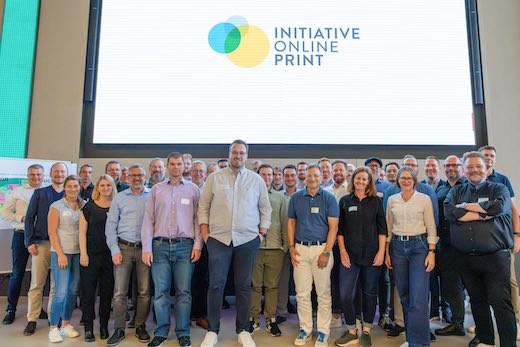[ad_1]

Many members of the Initiative Online Print took part in the two-day bootcamp on artificial intelligence and developed concepts for their own companies. Copyright: Initiative Online Print
How artificial intelligence could change the online print industry was the topic of the first AI bootcamp of the Initiative Online Print (IOP). The content included possible applications of AI in practice: in small groups, the IOP members were also able to work together on initial, practical projects that should also be implemented in their own companies.
It has been THE dominant topic in the media for months: artificial intelligence. But how can ChatGPT, Midjourney and Co. be actively – and above all profitably – used in practice? What possibilities do these new tools bring with them, what influence do they have on companies in the online print industry and to what extent can they be used for process optimisation or even for new business ideas? The participants of the IOP bootcamp dealt with these and other questions. For two days, they learned, tried out and developed at the invitation of the Media-Print Group GmbH at the Fraunhofer Institute in Paderborn. The central result: AI opens up many possibilities for the online print industry. It even offers smaller companies the potential to optimise production processes, personalise customer experiences and strengthen their competitiveness in a dynamic market.
Bernd Zipper, Board Chairman of the IOP, sums up: “Our bootcamp proved that one can get to grips with AI and work with it in a short time. It is important to seize the opportunities now to be at the forefront of new developments and to use AI for one’s own company. However, research work in the field needs to be significantly promoted.”
Print and AI complement each other
Prof. Dr Peter Posch from the University TU Dortmund gave the IOP members an overview of the different tools, what they are used for and where their strengths and weaknesses lie. After the questions of how to train the AI with one’s own print-relevant know-how and how to achieve the best possible result with as little effort as possible (keyword “the perfect prompt”) were clarified, things got very practical. In the working groups with the focus areas Creation, Production, Sales and Supply Chain Management, the IOP members gave free rein to their ideas in the “Makeathon” and developed concepts in a short time on how they can use AI in their own companies.
The conclusion of all groups was: print and artificial intelligence can complement each other constructively. In the production workflow, among other things, AI offers a new dimension of automation that can facilitate numerous work steps even for complex products and processes. For example, production planning and processes as well as logistics can also be optimised and, as a result, higher energy efficiency can be achieved and additional capacities leveraged.
Not fewer, but different jobs
Concerns about AI were also raised, especially that it could lead to massive job losses. The conclusion: AI makes some jobs easier and will replace some others. At the same time, however, it will also create new jobs, only at different levels. In the field of online printing, for example, specialists will be needed in the future who can create the right prompts, i.e. who supply the AI with orders. They will also have to implement “real” apps and algorithms from the responses of ChatGPT, Midjourney and co. and integrate them into the internal structures.
The world of work continues to develop – as it has done in the past, but now also through the use of artificial intelligence.
[ad_2]
Source link
